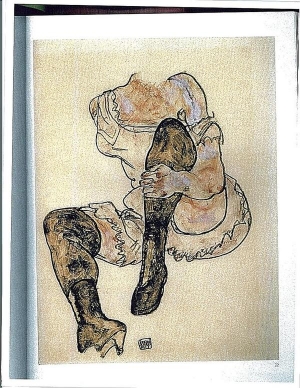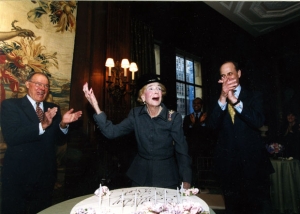|
Displaying items by tag: dispute

When the influential American painter Cy Twombly (1928-2011) passed away two years ago, he left the bulk of his artwork and millions of dollars in cash to the Cy Twombly Foundation of New York. The wealth of money and art passed from a trust to the foundation, which is devoted to protecting and promoting Twombly’s legacy. The Cy Twombly Foundation now finds itself embroiled in a lawsuit that was filed on Wednesday, March 13, 2013 in a Delaware state court.
The lawsuit claims that Thomas H. Saliba, one of the four individuals in charge of the foundation, took over $300,000 in unauthorized fees for investment services and assisted another foundation director, attorney Ralph E. Lerner, in pocketing funds. The claim was filed by Nicola Del Roscia, Twombly’s companion and the foundation’s president, and Julie Sylvester, a curator, Twombly expert, and the foundation’s vice president. Roscia and Sylvester also assert that Lerner and Saliba inflated the value of Twombly’s works in order to pad commissions for their own financial gain. Lerner and Saliba have refused to disclose their trustee commissions, making it impossible to determine the extent of their wrongdoing.
The recent lawsuit comes a month after Lerner asked the same Delaware court to appoint Twombly’s son, Alessandro, as a fifth board member in order to break the stalemate over the dispute. Roscia and Sylvester stated in recent court filings that Lerner’s request was an attempt to outmaneuver them. Roscia and Sylvester claim that Lerner hoped to bring Alessandro, the third trustee of Twombly’s trust, on board to help cover up Saliba’s wrongdoing.
While Twombly is a powerful force in the art market, highly inflating the prices of his work could prove dangerous for the foundation by creating confusion about the true value of his art and in turn destabilizing the Twombly market.

Over the course of 25 years in the 1980s and 1990s, Harry Rodman, a veteran gold refiner from New York City, and Alan Bronstein, a diamond dealer from New Jersey, assembled the Aurora Pyramid of Hope Diamonds, the most comprehensive collection of colored diamonds in the world. Featuring 295 rare gems, the collection became a point of controversy after Rodman died at the age of 99 in 2008.
Last year, Rodman’s heirs hit Bronstein with a lawsuit claiming that they were entitled to Rodman’s half of the diamond collection, which one appraiser valued at $14 million. The case became more complicated as Rodman, who made several wills in the last ten years of his life, was not only Bronstein’s partner, but also his stepfather. The legal dispute recently came to a close when Bronx Surrogate Judge Lee L. Holzman ruled that Bronstein fairly bought out Rodman’s interest in the Aurora Pyramid collection as well as another well-known grouping of diamonds known as the Aurora Butterfly of Peace.
The Aurora Pyramid of Hope, which is currently on loan to London’s Natural History Museum, has been exhibited at the Smithsonian Institution in Washington, D.C. and the American Museum of Natural History in New York. Bronstein plans to keep exhibiting the collection in museums for the benefit and enjoyment of the public.

On October 11, the Second Circuit Court of Appeals decided that the current owner of Egon Schiele’s Seated Woman with Bent Left Leg (Torso) could keep the drawing he purchased in the early 1960s from a gallery in Manhattan. Featuring the artist’s signature muted color palette, the work has been at the center of a seven-year-long legal battle.
The dispute arose when heirs to Fritz Grunbaum, a Viennese cabaret singer who was murdered by Nazis in 1941, claimed that the work had been unlawfully confiscated from Grunbaum’s estate in 1938. Although David Bakalar currently owns the drawing, Grunbaum’s heirs, Milos Vavra and Leon Fischer, considered themselves to be the rightful proprietors. When Bakalar attempted to sell Seated Woman at Sotheby’s London in 2004, Vavra and Fischer stopped the sale. Bakalar, who had bought the Schiele drawing from Galerie St. Etienne for about $3,300, was attempting to sell the work for about $675,000.
Although Grunbaum was a noted collector of Schiele’s work, there was no direct evidence that he had owned Seated Woman or that Nazis had confiscated the drawing. However, evidence emerged that Grunbaum’s sister-in-law, Mathilde Lukacs, sold the drawing in Switzerland in 1956. The Swiss dealers who had purchased the drawing from Lukacs testified in the case and provided records of the sale. Based on this evidence, the U.S. District Court ruled that Grunbaum was most likely not the drawing’s owner and that Nazis had not stolen the piece, rather, it had stayed with the family until the sale in 1956.
The Court’s ruling was particularly significant because Bakalar had employed New York’s “laches defense,” a defense that is used by good-faith buyers to protect themselves against frivolous claims. While Schiele’s heirs claimed that if Lukacs had owned the drawing it was because she had stolen it from Grunbaum, Bakalar argued that the fact was irrelevant because no claims had been filed and that crucial evidence had disappeared over the decades.

After a confrontation that lasted 10 months, staff members at San Francisco’s Legion of Honor and M.H. de Young museums agreed on a new contract with their employer, the Corporation of Fine Arts Museums (COFAM).
When COFAM and the Services Employees International Union (SEIU) began working to replace the contract that expired in October 2011, accusations of stubbornness, obstructionism, and disregard for the museums’ fiscal stability abounded on both sides.
Electricians, security guards, graphic artists, retail staff, and office administrators voiced their dissatisfaction with COFAM. The dispute peaked last May when Eric Mar, the San Francisco city supervisor who once served as a shop steward of the SEIU, wrote a piece for the San Francisco Examiner supporting the union, complaining about wage freezes, and arguing that the fact that COFAM requires workers to contribute to their own healthcare coverage was unfair. Another peak in the argument was reached this past August when many union members formally approved a strike. On September 7th, protestors gathered outside of the de Young during the museum’s popular event, “Friday Nights at the de Young Museum” catching the media’s attention.
Two weeks after the protest, COFAM stated that they reached a “tentative accord” with the union. The agreement provided 100 members with a 12 to 18 percent pay raise during the three years that their new contract is in effect. That raise is in addition to a three percent pay increase upon signing the new contract and another three percent raise on January 1, 2013.
While employee contribution to health care coverage was a huge point of contention in the dispute, most workers will still be required to make minimal payments. Employees will pay on a sliding scale that starts at $25 per month for employees, $50 for one dependent, and $75 for families.

Before her death in 2007, Brooke Astor was a fixture in New York City’s elite inner circle. A tireless philanthropist and champion of the arts, Astor left behind a legacy marked by kindness, generosity, and good taste.
Sotheby’s has announced an auction of the contents of two of Astor’s estates – her legendary Park Avenue duplex and her country estate, Holly Hill, in Briarcliff Manor, NY. A total of 901 items including European and Asian furnishings, Old Master paintings, Qing Dynasty paintings, tea sets, silverware, jewelry, a porcelain menagerie, and over 100 dog paintings will head to the auction block September 24–25. Per Astor’s request, proceeds from the sale will go to the institutions and causes she held dear including the New York Public Library, the Metropolitan Museum of Art, the Bronx Zoo, Central Park, the Animal Medical Center of New York, New York City’s public school system, and a number of charities in Maine. Sotheby’s expects the sale to bring in between $6 and $9 million for the entire collection.
An icon of New York society and refinement, Astor spent her final years suffering from dementia. After her death at 105, her estate remained in limbo due a family dispute that lasted five years. The feud ended in March of 2012 and $100 million of Astor’s estate was freed for her charities. The amount going to Anthony Marshall, her only son, was cut by more than half as he was convicted of taking advantage of his mother’s deteriorating mental state and altering her will to his advantage.
Among the most coveted of Astor’s pieces that will be headed to Sotheby’s are an Imperial Chinese gilt-bronze lion clock slated to bring in around $180,000–$220,000 and an emerald and diamond necklace with earrings estimated at $280,000– $390,000 for both.
|
|
|
|
|